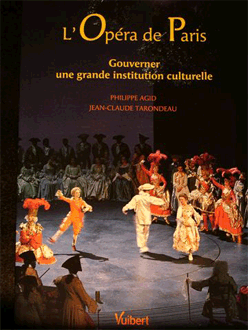The Paris Opera
The Management and Governance
of a Major Cultural Institution
A book written by Philippe Agid &
Jean-Claude Tarondeau
Contenu
After having dealt with one of its worst crises at the beginning of the 1990s the Paris Opera saw a regeneration of its lyrical and ballet activities, accompanied by changes in its management, within the mandate of Hugues Gall, between 1995 and 2004.
Under what conditions could the economically based and new-found stability be maintained, and even improved, in the future?
In terms of governance and overall results, how does the Paris Opera of today compare with the most famous of its former incarnations, that of Lully the composer, “entrepreneur” and head of a monopoly for all the opera activities in France; of Picard under the semi-autocratic guardianship of Napoleon; that of Veron to Rouche between 1831 and 1939; that of the weakened public institution from 1945 to 1994, despite the artistic enlightment of the Liebermann Era? How does it compare today with three similarly important opera houses , the New York Metropolitan Opera, the Vienna Staats Oper, and the Bayerische Staats Oper in Munich?
Convinced of the progress that can be expected from a strengthened opera governance, the authors outline the improvements that are now possible in order to reinforce the Paris Opera stability and efficiency of an institution.
 Discover the new book by Philippe Agid and Jean Claude Tarondeau.
Discover the new book by Philippe Agid and Jean Claude Tarondeau.
The Management of Opera

Contact | Sitemap | Legal Note | Credits

